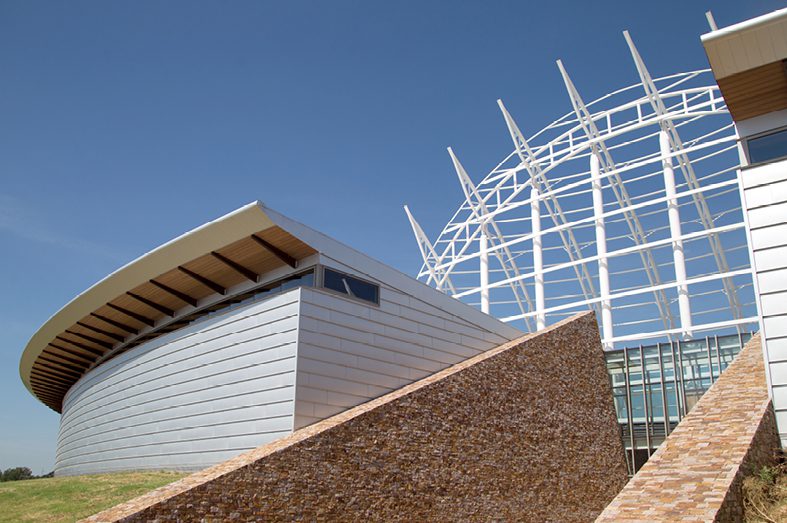
In 1986, the Oklahoma State Department of Tourism and Recreation kicked off a quiet, largely unnoticed exploration of opportunities to pump up the state’s then-lackluster economy by boosting tourism. Its final conclusion – unsurprising at best, completely obvious at worst – pointed right at Oklahoma’s rich and textured American Indian culture as something that might pull in a lot of paying customers. Almost 30 years later, the very bold and loud answer to that first, quiet question sits along the Oklahoma River just south of Oklahoma City’s central business district. The American Indian Cultural Center and Museum (AICCM) is a world-class steel, glass and concrete tribute to the culture, art and history of Oklahoma’s 39 tribes. It’s also unfinished.
Over the years of its planning and development, the Center has morphed into something far bigger than a tourism paycheck. It will be the largest and most important showcase of American Indian history and culture outside of the Smithsonian’s National Museum of the American Indian. Its exhibits, fully interactive and capable of making a more lasting impression than the usual static museum displays, walk visitors unabashedly through the good and the bad of tribal history in Oklahoma. From the horrors of the Trail of Tears to the bright future of Natural Democracy, it’s all there. It’s a standing, permanent cultural reconciliation of sorts. Oklahoma’s been looking for something like this for a lot longer than 30 years[pullquote].“When completed, The Center will deliver an authentic, world-class cultural destination with a remarkable visitor experience.”[/pullquote]
With a vitally important cultural statement and $4 billion of tourism dollars over 20 years at stake, why aren’t the doors opening? Tens of millions of dollars have been sunk into the center, and the majority of construction is complete. “We’re on the first-yard line at the beginning of the fourth quarter,” says Sen. Kyle Loveless (R-Oklahoma City), once a skeptic but now a tireless champion of the AICCM.
Since its celebratory Groundblessing in May 2005, the Center’s construction’s proceeded in fits and spurts, frustrated by changing economic conditions and pitfalls in funding. The 2012 Oklahoma Senate’s refusal to issue $40 million in bonds to help bridge the final $80 million gap to completion is only the latest in a series of setbacks. The remaining $40 million in matching funds from tribal, private and other supporters is ready to go, contingent upon the state’s buy-in.
For the last decade, the AICCM’s executive director, J. Blake Wade, has found himself constantly reminding Oklahomans of the importance of the Center’s completion. “When completed, The Center will deliver an authentic, world-class cultural destination with a remarkable visitor experience,” he says. “No other state can share the collective history of 39 distinctive nations. The development of exhibitions and construction that meet Smithsonian standards requires diligence and an unyielding commitment to quality, to ensure the full vision is realized. When completed, this place will stand with other cultural institutions such as the Sydney Opera House and Smithsonian’s National Museum of the American Indian, both of which took considerably longer to develop than originally anticipated. But both have been well worth the wait.”
Wade and his colleagues and supporters at the AICCM aren’t the only ones tearing their hair out. Plenty of Oklahoma legislators are tired of going to the well for the Center. They want to see the Center completed. They support the Center and its mission. But the well might be dry.

The Center’s original funding plan was built on an assumption of federal assistance. Two U.S. senators and four U.S. congressmen assured the state that Uncle Sam would pick up one-third of the tab. The state put its chips down. Private contributors, tribes and the City of Oklahoma City pulled seats up to the table. Construction began. Three years passed, and it became clear that the federal government had no interest. By 2008, the waiting got old. The Oklahoma senate approved $25 million in bond funding to keep the project going.
Then there’s good, old-fashioned caprice. Hurricane Katrina slammed into the Gulf of Mexico, blowing construction costs through the roof across the nation. In 2008 the country began a long slide into the deepest recession since the Great Depression. The cost of everything rose, and funds fell short.
Critics have levied charges of fraud, abuse and wastefulness against AICCM. Accusations of suspect bid selection popped up here and there. In an effort to quash rumors and end the finger-pointing, Gov. Mary Fallin called in the Oklahoma State Auditor and Inspectors Office. The final verdict: the AICCM is squeaky clean. It’s shown complete fiscal responsibility while dealing with uncontrollable outside forces and setback after setback with funding.
“Critics say that the Devon Tower was built for less and in a fraction of the time. It’s true,” says Loveless. “Funds for the entire building were in place before construction started. That makes things move quicker and cheaper. The AICCM didn’t have that, and it’s a project shared by three levels of government, several tribes and outside contributors. Funding shortfalls, coordination of so many agencies, and some bad luck. It’s not hard to see why it’s taken so long.”
Loveless and Wade are hopeful. They used the 2013 legislative session productively, capturing lost ground. The newest proposal in front of the legislature calls for a funding package split over three years. It was scheduled for a vote at the end of the recent legislative session, but once again the AICCM found itself at the mercy of outside forces. The tornados in Moore and Shawnee hit, and the legislature rightly gave the matter its full attention. Senate Pro Tem Brian Bingman and House Speaker T.W. Shannon, however, have agreed to postpone the vote until early in the 2014 session. The move is a little unconventional, but the bill has made its way through committees and is ready to go.
For now, the only visitors the Center sees are the maintenance men that routinely check the facility’s core systems and security guards that stand watch around the clock. Bitter AICCM supporters point to the uncompleted facility as another broken promise. Those willing to fight on do so without rancor, tirelessly explaining the importance –economic and cultural – of AICCM and carefully putting the pieces in place to ensure its survival. And many legislators that opposed the Center’s funding in the past are comfortable with the new plan or are at least willing to approach it with an open mind. The smart money says, despite the arduous road getting there, the doors of the AICCM will swing open, Oklahoma will see an unprecedented tourism windfall and the state’s rich Native American legacy will be have a fitting monument.

























